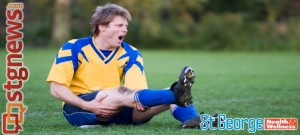
FEATURE – Participation in sports or exercise is an important step in maintaining your health. Exercise strengthens your heart, bones and joints and reduces stress, among other health benefits. Unfortunately, injuries during sports and exercise are all too common.
With so much information available on how to manage common athletic injuries, the goal of this article is to establish a system to bring you through the healing process of overuse injuries and provide tools to prevent future injuries. The specific goals of this system are to:
- Decrease muscle spasms and tension through self myofascial release
- Break up soft tissue and joint restrictions through mobilization techniques
- Use appropriate stretching to improve and maintain mobility in the injured area to allow for healing
- Provide support to the injured area with kinesiology tape
- Implement appropriate strengthening exercises to restore muscle balance and function
Myofascial release
Most commonly performed on a foam roll, myofascial release uses body weight to massage away restrictions to normal soft-tissue extensibility. The soft tissue system is composed of muscles, tendons, ligaments and fascia. Tightness and adhesions in soft tissue restricts range of motion compromising efficiency in movement. This leads to poor movement patterns, premature fatigue and injury. Implementing this simple technique will help improve flexibility, function and performance while reducing injuries.
Mobilization techniques
Joint mobilization is a treatment technique used to manage dysfunctional motion by restoring joint play or movement that has been lost due to injury or disease. In addition to aiding in the restoration of normal motion, the gentle back-and-forth movements utilized in mobilization help to decrease the perception of pain. While mobilization is usually best performed by a doctor or therapist who understands proper anatomy and biomechanics, basic self-mobilization is possible using force that mimics the movement of a joint while performing oscillatory or hold and stretch movements.
Stretching
Stretching increases flexibility and can help improve performance while reducing risk of injury. Not all stretching, however, is good. Forcing your muscles to stretch farther than they are able, particularly when already compromised by injury, can result in further damage. Here are some basic recommendations for healthy stretching:
- You should not use stretching as a warm-up activity. Instead, warm up before you stretch to help protect a “cold” muscle from strain.
- Stretching should never hurt. The goal is to only go as far as you can, comfortably. Once you feel a pull or stretching sensation, stop there. That way you can build on each stretch without risking injury.
- You will always get more out of frequency instead of one intense session per week. Shoot for 20 to 30 second holds and two to four repetitions.
- Do not stretch an injured muscle.
Kinesiology taping
Kinesiology taping is based on the idea that the body can heal itself if enabled with appropriate support. Kinesio-tape works like an external ligament to provide extra support and stability for muscles and joints while still allowing full range of motion. It also helps activate muscles and improve the balance and stability of joints. The tape can also facilitate muscle and soft tissue healing and trigger the body’s natural painkillers. By microscopically lifting the skin, both lymph flow and microcirculation improve, which ultimately helps to cool and flush fluid and waste products away from injured areas.
Strengthening
Strength training programs designed with the intention of recovering from or preventing injuries should be dedicated to helping you correct muscle imbalances and regain strength. Exercises performed should be designed to make positive changes in the way you move, and focus on the underlying weakness or muscular imbalance that predisposes you to pain, injury and the resulting compensation patterns. When implemented correctly, a strength training program should allow you to return to daily work-related and sports activities in a safe and effective way.
All of these steps should be used in combination when dealing with injuries, and all can be learned and performed on your own with the help of the appropriate resources. When dealing with any injury or exercise program it is, of course, recommended that you consult with your doctor. PerforMed offers effective therapeutic approaches for many athletic injuries, as well as helping the athlete, at any level, perform at their best potential. Follow the PerforMed blog to learn how to implement this system for specific injuries or complaints.
Written by Dr. Mikel D. Richter, M.S., D.C., for St. George Health and Wellness magazine and St. George News.
Richter is a chiropractic sports physician specializing in biomechanics, athletic injuries and human performance. He received his doctorate in chiropractic and a master’s degree in sports science and rehabilitation with an emphasis in nutrition and human performance from Logan College of Chiropractic in St. Louis, Mo. He is excited to be a part of the active Southern Utah community and to be the official chiropractor of Dixie State Athletics. For questions or more information on PerforMed, contact Richter at [email protected] or call 435-703-9676.
St. George Health and Wellness
Email: [email protected]
Twitter: @STGnews
Copyright St. George News, StGeorgeUtah.com Inc. and St. George Health and Wellness magazine, 2013, all rights reserved.


There are some great strength training manuals out there that hold awesome additions to the fitness methods you learn at the traditional gym or the popular MMA and Crossfit methodologies. Anybody who is looking for an alternative to their daily fitness routine, spectacular additions, or aspirations should check out the manuals produced by Al Kavadlo, Paul Wade and Christopher Sommer. The Russian kettlebell guru, Pavel Tsatsouline, has got some incredibly useful additions as well, although many fitness enthusiasts will probably have already been introduced to his methods.